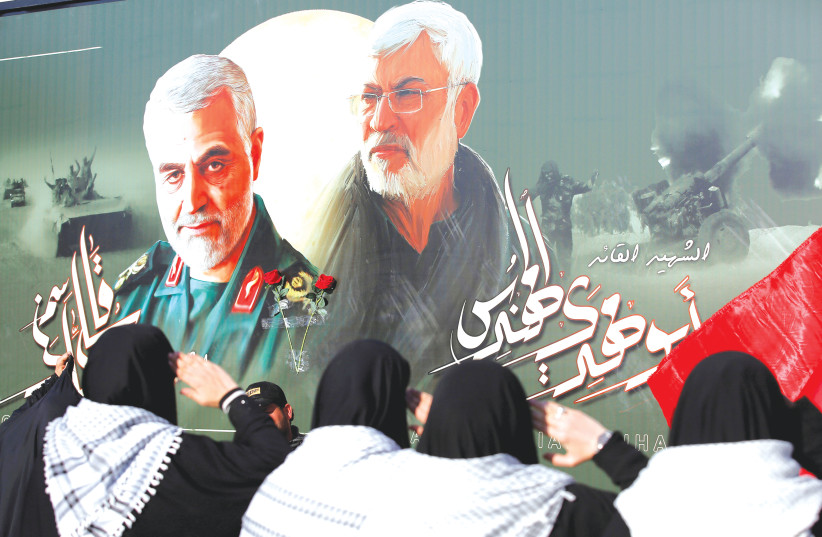On Wednesday Abu Fadak al-Mohammadawi, was listed as a Specially Designated Global Terrorist.
SETH J. FRANTZMAN

Abu Fadak has a habit of avoiding the cameras.
However, he was thrust into the limelight after the US used a drone to kill Abu Mahdi al-Muhandis in January last year.
Muhandis was the deputy of the Popular Mobilization Units, a group of mostly Shi’ite militias in Iraq.
Muhandis was a key operator who was responsible for terror attacks in Kuwait in the 1980s and ran one of Iraq’s most disciplined pro-Iranian militias.
Muhandis was the head of the Kataib Hezbollah.
In the waning days of the Trump administration US Secretary of State Mike Pompeo has sought to sanction and designate a large number of people and groups, and countries, as terrorists or terror supporters. He has targeted the Iranian-backed Houthis in Yemen, Cuba and also alleged Iran is a base for Al-Qaeda.
On Wednesday Abu Fadak al-Mohammadawi, was listed as a Specially Designated Global Terrorist. It comes days after the US targeted Abu Fadak’s boss, Falih al-Fayyadh. Fayyadh has been head of the PMU and played a role in the attack on the US embassy in 2019 in Iraq. Fayyadh was close to Muhandis, his deputy, and IRGC leader Qasem Soleimani.
The US killed Soleimani and Muhandis in the same strike.
Abu Fadak, the US says, is also called Al-Khal, the “uncle.” He was born in 1968. The US mistakenly listed him as linked to the Islamic State or ISIS. In fact Fadak’s Kataib Hezbollah is a pro-Iranian Shi’ite group that fought ISIS, which is a fascistic genocidal Sunni jihadist group with roots in Al-Qaeda.
The mistake in the US Treasury listing is immaterial. Fadak is a key player in Kataib Hezbollah and Iran’s network in Iraq. That his group fought ISIS doesn’t make it substantially different in its role, it is another side of the coin of extremists in Iraq.
The uncle, Abu Fadak, was not well known before he was elevated to leadership in 2020. He was a close friend of Soleimani, according to reports. He used to be a member of the Badr Organization run by Hadi al-Amiri. Al-Amiri runs the Fatah Alliance party, the second largest party in Iraq. Badr was once a key to the IRGC influence in Iraq and was made up of Iraqis who had fought alongside Iran against Saddam’s regime.
Kataib Hezbollah was the tip of the Iranian speer in Iraq, unlike the larger Badr which controlled the Interior Ministry and spread itself out like a carpet over Shi’ite areas. Badr operationalized numerous brigades to fight ISIS in 2014 as part of the populist fatwa of Ayatollah Sistani.
It built up minority units as well, such as Shebeks and others. Kataib Hezbollah remained smaller and more dedicated to a singular role. In May 2019 as tensions rose with the US Kataib Hezbollah was operationalized to fire 107 mm rockets at US forces in Iraq. Dozens of attacks took place, culminating in the killing of a US contractor near Kirkuk in December 2019.
The US responded with airstrikes and Muhandis and others led a march on the US embassy. Soleimani flew in to lead the struggle against the US. Before he could get started he and Muhandis were immolated in the airstrike. The uncle was called by Tehran to take up the reins.
That is largely what we know about Abu Fadak. Iranian-backed militias like Kataib Hezbollah have also played a role in weapons trafficking to Hezbollah, a kinship group, in Lebanon. They had forces in Syria. In 2018 an airstrike destroyed one of their headquarters in Albukamal in Syria near the Iraqi border.
More airstrikes in the summer of 2019 targeted warhouses on PMU bases that housed weapons, perhaps Iranian ballistic missiles or other ordnance. Iran is believed to have sent ballistic missiles to Iraq in 2018 and 2019 to PMU sites. PMU groups have threatened Israel from Iraq. Asaib Ahl al-Haq leader Qais Khazali even went to Lebanon to near the border with Israel and threatened Israel in 2017.
Michael Knights at the Washington Institute for Near East Studies noted on January 13 that “Kataib Hezbollah (KH), the powerful Iranian-backed militia whose ranks he joined years ago, has admitted that he played a leading role in launching rockets against US targets, training Bahraini terrorists, and fighting in Syria under the command of Iran’s Islamic Revolutionary Guard Corps-Qods Force (IRGC-QF). Many of these activities were conducted after the PMF become a formal part of the Iraqi armed forces in 2014, and he pursued them without authorization from the nation’s commander-in-chief.”
It appears the Uncle does not have the Noblesse oblige of men like Muhandis and Soleimani. He doesn’t have the touch. He has slouched from one failure to the next. According to Knights he played a problematic role in a kidnapping of Qatari royals in 2017. He alienated units in the PMU that are territorially linked to various Shi’ite shrines, and he has taken on the new Iraqi Prime Minister Mustafa al-Kadhimi. Now he has gotten himself sanctioned, although that may raise his profile.
Video of Abu Fadak includes several times when he claimed he would appear and then cancelled a news conference and other video of him fleeing the cameras. Attempts to try to show him off as a successor to Muhandis have not been successful and has left the PMU divided and Iran’s ambitions in Iraq a bit frustrated.
His stature may increase now as Iran sanctions could be reduced and money could flow from Iran again to its allies in Iraq, Syria and Lebanon. Sanctions on him won’t have much impact, since he doesn’t appear to travel outside a narrow orbit and he is anyway extremely careful about making appearances. He doesn’t want to end up like Soleimani, Muhandis, Imad Mughniyeh and others linked to Iran who have met a surprising demise.
…
Content retrieved from: https://www.jpost.com/middle-east/the-us-targets-irans-key-henchman-abu-fadak-in-iraq-655405.